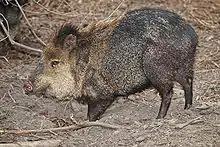Pecari
Pecari is a genus of mammals in the peccary family, Tayassuidae.[1] The genus was monotypic until the description of P. maximus in 2007,[2] but the scientific evidence for its status as a species separate from P. tajacu has later been questioned,[3][4] leading the IUCN to treat it as a synonym.[5]
| Pecari | |
|---|---|
 | |
| Collared peccary | |
| Scientific classification | |
| Kingdom: | Animalia |
| Phylum: | Chordata |
| Class: | Mammalia |
| Order: | Artiodactyla |
| Family: | Tayassuidae |
| Genus: | Pecari Reichenbach, 1835 |
| Species | |
|
Pecari maximus | |
Species
- Pecari maximus Roosmalen et al., 2007 – giant peccary (Brazil) - disputed
- Pecari tajacu Linnaeus, 1758 – collared peccary (Southwestern United States, Mexico, and Central and South America)
References
- Groves, C. P. (2005). Wilson, D. E.; Reeder, D. M. (eds.). Mammal Species of the World: A Taxonomic and Geographic Reference (3rd ed.). Baltimore: Johns Hopkins University Press. ISBN 0-801-88221-4. OCLC 62265494.
- Roosmalen, M.G.M.; Frenz, L.; Hooft, W.F. van; Iongh, H.H. de; Leirs, H. 2007. A New Species of Living Peccary (Mammalia: Tayassuidae) from the Brazilian Amazon. Bonner zoologische Beiträge 55(2): 105–12.
- Gongora, J., Taber, A., Keuroghlian, A., Altrichter, M., Bodmer, R.E., Mayor, P., Moran, C., Damayanti, C.S., González S. (2007). Re-examining the evidence for a ‘new’ peccary species, ‘Pecari maximus’, from the Brazilian Amazon. Newsletter of the Pigs, Peccaries, and Hippos Specialist Group of the IUCN/SSC. 7(2): 19–26.
- Gongora, J., Biondo, C., Cooper, J.D., Taber, A., Keuroghlian, A., Altrichter, M., Ferreira do Nascimento, F., Chong, A.Y., Miyaki, C.Y., Bodmer, R., Mayor, P. and González, S. (2011). Revisiting the species status of Pecari maximus van Roosmalen et al., 2007 (Mammalia) from the Brazilian Amazon. Bonn Zoological Bulletin 60(1): 95–101.
- Gongora, J.; Reyna-Hurtado, R.; Beck, H.; Taber, A.; Altrichter, M. & Keuroghlian, A. (2011). "Pecari tajacu". The IUCN Red List of Threatened Species. IUCN. 2011: e.T41777A10562361. doi:10.2305/IUCN.UK.2011-2.RLTS.T41777A10562361.en. Retrieved 10 January 2018.
This article is issued from Wikipedia. The text is licensed under Creative Commons - Attribution - Sharealike. Additional terms may apply for the media files.